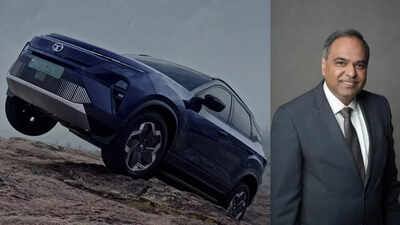Why Tata Motors didn’t rebrand ‘Harrier’ EV: Company eyes 50% EV share

Based on an interaction conducted by Arpit Mahendra. Tata Passenger Electric Mobility has further expanded its lineup of electric cars with the highly-anticipated launch of the electrified version of its popular nameplate, the Harrier. With the launch of the Harrier EV, the company’s stable now consists of six models including the likes of Nexon EV and Punch EV. We recently spoke with Shailesh Chandra, Managing Director of Tata Passenger Electric Mobility, who explained the arrival of the electrified Harrier, explaining its significance, technology, and market positioning.Chandra highlighted the rapid growth of the SUV segment, which now accounts for over 50% of the total passenger vehicle market in India. Within this, the large SUV segment (vehicles over 4.5 metres long and priced above Rs 20 lakh) has become a sizable category, clocking around 25,000 units a month. This segment, he noted, is typically composed of customers who are upgrading; thus seeking enhanced performance, features along with spacious cabins and premium technology. That said, the Harrier EV will be competing in this segment.
Tata Harrier EV – Positioning and targeted customers
When asked about the positioning of the Harrier EV, especially in relation to the ICE Harrier, Chandra said the EV version is targeted at a more discerning audience: young professionals, tech-savvy individuals, and those open to exploring new technologies. “These might be people upgrading from a segment below or even coming down from more expensive cars because of the value this product offers,” he explained.On that note, he further pointed out that “This car delivers nearly 40-45% better torque and acceleration than what a typical car would be giving in this segment in the ICE world”. While most ICE-powered SUVs offer around 350 Nm of torque, the Harrier EV churns out 500 Nm and achieves 0-100 kmph in just 6.3 seconds. It also features dual motors powering all four wheels, making it Tata’s first all-wheel-drive EV.On the technology front, he highlighted that the Harrier EV is the first car in the industry to feature a Samsung Neo QLED screen, offering a “superior” picture quality. Besides that the SUV also features an industry-first 540-degree camera system, which not only offers a 360-degree view but also lets drivers see what’s underneath the car.
Tata Harrier EV: Why ‘Harrier’ EV?
Interestingly, despite the all-new EV platform and significant changes under the skin, Tata decided to retain the “Harrier” nameplate. Chandra revealed that this was a matter of internal debate. “There was all the reason to go with a new top hat and a new name. But Harrier is strongly associated with the JLR architecture and has established a premium brand image. We wanted to piggyback on that strength,” he said. That said, Tata’s new EV platform will also be used for other models in different shapes and styles in the future, he confirmed.
TPEM aiming for 50 percent market share in the EV segment
Looking ahead, Chandra stated that while the overall market for electric vehicles is still small, Tata Motors has significant ambitions. The company expects 30% of its passenger vehicle volumes to come from EVs by 2030, compared to the current 11-12%. At an industry level, he expects EV penetration to reach 15-20%. Tata Motors currently enjoys over 10% EV market share in India and remains committed to retaining the top spot. “We are very particular about that. In the mid-to-long term, we are taking actions to ensure 50% market share,” he said.He further broke down the EV market into three segments: entry, mid, and premium. The entry segment consists of city-oriented cars like the Tiago and Punch EVs, while the mid segment – featuring models like the Nexon EV and Curvv EV, is where most of the action happens, accounting for about 6,000–6,500 units per month. That said, he explained that it will be possible to capitalize on the company’s wide portfolio when the market grows further.





